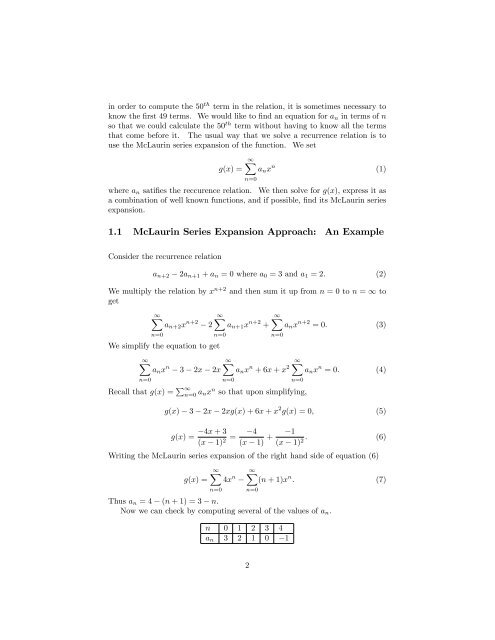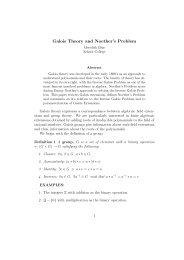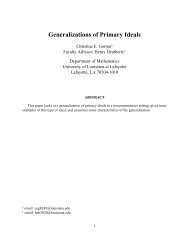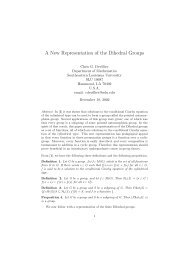Solving Recurrence Relations Using Differential Operators - Sections
Solving Recurrence Relations Using Differential Operators - Sections
Solving Recurrence Relations Using Differential Operators - Sections
Create successful ePaper yourself
Turn your PDF publications into a flip-book with our unique Google optimized e-Paper software.
in order to compute the 50 th term in the relation, it is sometimes necessary to<br />
know the …rst 49 terms. We would like to …nd an equation for an in terms of n<br />
so that we could calculate the 50 th term without having to know all the terms<br />
that come before it. The usual way that we solve a recurrence relation is to<br />
use the McLaurin series expansion of the function. We set<br />
g(x) =<br />
1X<br />
anx n<br />
n=0<br />
where an sati…es the reccurence relation. We then solve for g(x), express it as<br />
a combination of well known functions, and if possible, …nd its McLaurin series<br />
expansion.<br />
1.1 McLaurin Series Expansion Approach: An Example<br />
Consider the recurrence relation<br />
an+2 2an+1 + an = 0 where a0 = 3 and a1 = 2: (2)<br />
We multiply the relation by x n+2 and then sum it up from n = 0 to n = 1 to<br />
get<br />
1X<br />
n=0<br />
an+2x n+2<br />
2<br />
1X<br />
n=0<br />
We simplify the equation to get<br />
1X<br />
anx n<br />
n=0<br />
an+1x n+2 +<br />
n=0<br />
(1)<br />
1X<br />
anx n+2 = 0. (3)<br />
n=0<br />
1X<br />
3 2x 2x anx n + 6x + x 2<br />
1X<br />
anx n = 0. (4)<br />
n=0<br />
Recall that g(x) = P 1<br />
n=0 anx n so that upon simplifying,<br />
g(x) 3 2x 2xg(x) + 6x + x 2 g(x) = 0; (5)<br />
g(x) =<br />
4x + 3<br />
=<br />
(x 1) 2<br />
4<br />
(x 1) +<br />
1<br />
: (6)<br />
(x 1) 2<br />
Writing the McLaurin series expansion of the right hand side of equation (6)<br />
g(x) =<br />
1X<br />
n=0<br />
4x n<br />
1X<br />
(n + 1)x n : (7)<br />
n=0<br />
Thus an = 4 (n + 1) = 3 n:<br />
Now we can check by computing several of the values of an.<br />
n 0 1 2 3 4<br />
an 3 2 1 0 1<br />
2

















